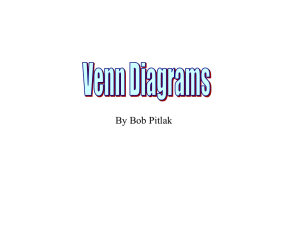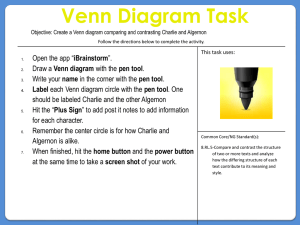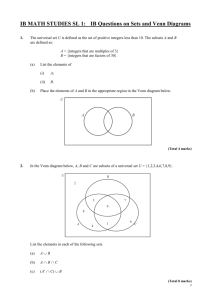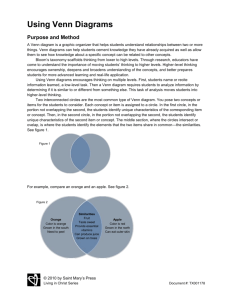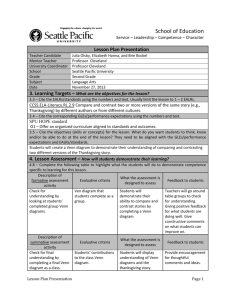File - Ms. Bartel
advertisement
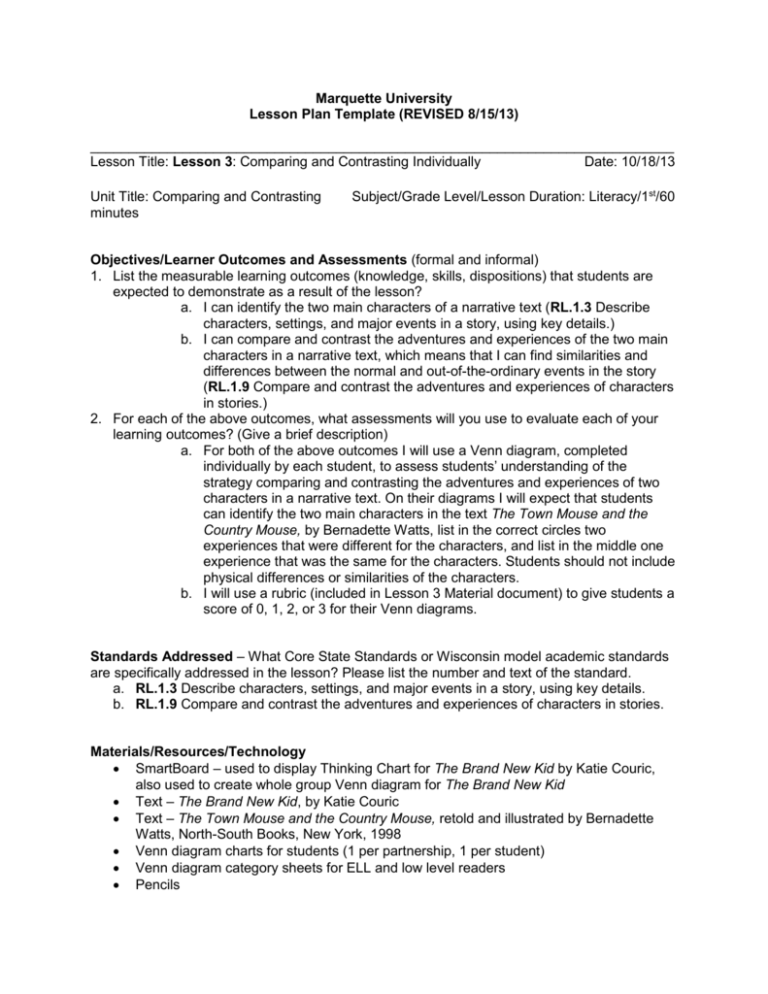
Marquette University Lesson Plan Template (REVISED 8/15/13) ____________________________________________________________________________ Lesson Title: Lesson 3: Comparing and Contrasting Individually Date: 10/18/13 Unit Title: Comparing and Contrasting minutes Subject/Grade Level/Lesson Duration: Literacy/1st/60 Objectives/Learner Outcomes and Assessments (formal and informal) 1. List the measurable learning outcomes (knowledge, skills, dispositions) that students are expected to demonstrate as a result of the lesson? a. I can identify the two main characters of a narrative text (RL.1.3 Describe characters, settings, and major events in a story, using key details.) b. I can compare and contrast the adventures and experiences of the two main characters in a narrative text, which means that I can find similarities and differences between the normal and out-of-the-ordinary events in the story (RL.1.9 Compare and contrast the adventures and experiences of characters in stories.) 2. For each of the above outcomes, what assessments will you use to evaluate each of your learning outcomes? (Give a brief description) a. For both of the above outcomes I will use a Venn diagram, completed individually by each student, to assess students’ understanding of the strategy comparing and contrasting the adventures and experiences of two characters in a narrative text. On their diagrams I will expect that students can identify the two main characters in the text The Town Mouse and the Country Mouse, by Bernadette Watts, list in the correct circles two experiences that were different for the characters, and list in the middle one experience that was the same for the characters. Students should not include physical differences or similarities of the characters. b. I will use a rubric (included in Lesson 3 Material document) to give students a score of 0, 1, 2, or 3 for their Venn diagrams. Standards Addressed – What Core State Standards or Wisconsin model academic standards are specifically addressed in the lesson? Please list the number and text of the standard. a. RL.1.3 Describe characters, settings, and major events in a story, using key details. b. RL.1.9 Compare and contrast the adventures and experiences of characters in stories. Materials/Resources/Technology SmartBoard – used to display Thinking Chart for The Brand New Kid by Katie Couric, also used to create whole group Venn diagram for The Brand New Kid Text – The Brand New Kid, by Katie Couric Text – The Town Mouse and the Country Mouse, retold and illustrated by Bernadette Watts, North-South Books, New York, 1998 Venn diagram charts for students (1 per partnership, 1 per student) Venn diagram category sheets for ELL and low level readers Pencils Section B: Introduction to Lesson Purpose – How will you state the purpose of the lesson? In order to introduce this lesson I will tell students that we are going to continue working on comparing and contrasting. I will put up the anchor charts for similarities and differences and for adventures and experiences in order to review the vocabulary that we have been working on. Prior Learning – what do the students know? What can they do? What are they learning to do? How will you make connections to prior learning? At this point students have been working on comparing and contrasting for two days. They know the vocabulary similarities, differences, compare, adventure, and experience. They have worked with Venn diagrams and Thinking Charts although they are still learning to think across both of these organizers. Today we will be making the connection between the Thinking Chart and the Venn diagram. I will model for students how we take the similarities that we marked on the Thinking Chart and place them into the correct spot on the Venn diagram. Then we will look at differences on the Thinking Chart and place them into the correct spots on the Venn diagram. Students will then do this same activity on their own as their final assessment for this lesson segment. Section C: Content/Procedures/Sequence (Include estimated time for each activity) Whole Group Thinking Review all of the vocabulary from previous lessons. Review The Chart to Venn diagram Brand New Kid, and pull up Thinking Chart that was created in a whole group at the end of lesson 2. Remind students that highlighted items were similarities between the experiences and adventures of the characters. Pull up Venn Diagram and ask Outcome a., b. students where to put similarities? Where to put differences? 20 minutes Model transferring information from the Thinking Chart to Venn diagram. Individual Thinking Reread the story The Town Mouse and the Country Mouse. Show Chart to Venn diagram students the Thinking Chart that I created as a model in lesson 2. Read through Thinking Chart but do not give specific attention to similarities and differences. Instructions: each student is to create, on their own, a Venn diagram comparing the similarities and differences of the adventure and experiences of the town mouse and the country mouse. Students should have at least two differences and one similarity, however they are encouraged to put more on their diagrams. If students complete their diagrams there will be a writing activity they can complete using the Venn diagram. They will need to name the two characters, give one similarity and one difference. There is then room to draw a picture. I will give students up to 40 minutes for this activity, although I believe it will take closer to 25 minutes. If students complete both activities then they will be allowed to quietly read one of their independent books. * I will have copies of the Thinking Chart available for students who appear to be struggling, especially for ELL and low level readers. If Outcome a., b. a student needs the chart I will encourage him/her to circle 20-40 minutes similarities on both sides of the chart (similar to what we did as a whole class in lesson 2). Section D: Closure After all diagrams have been handed in I will congratulate students on working so hard to learn a new strategy that will help them in their reading. I will encourage them to use this strategy while reading their independent books. No independent work will be assigned.


